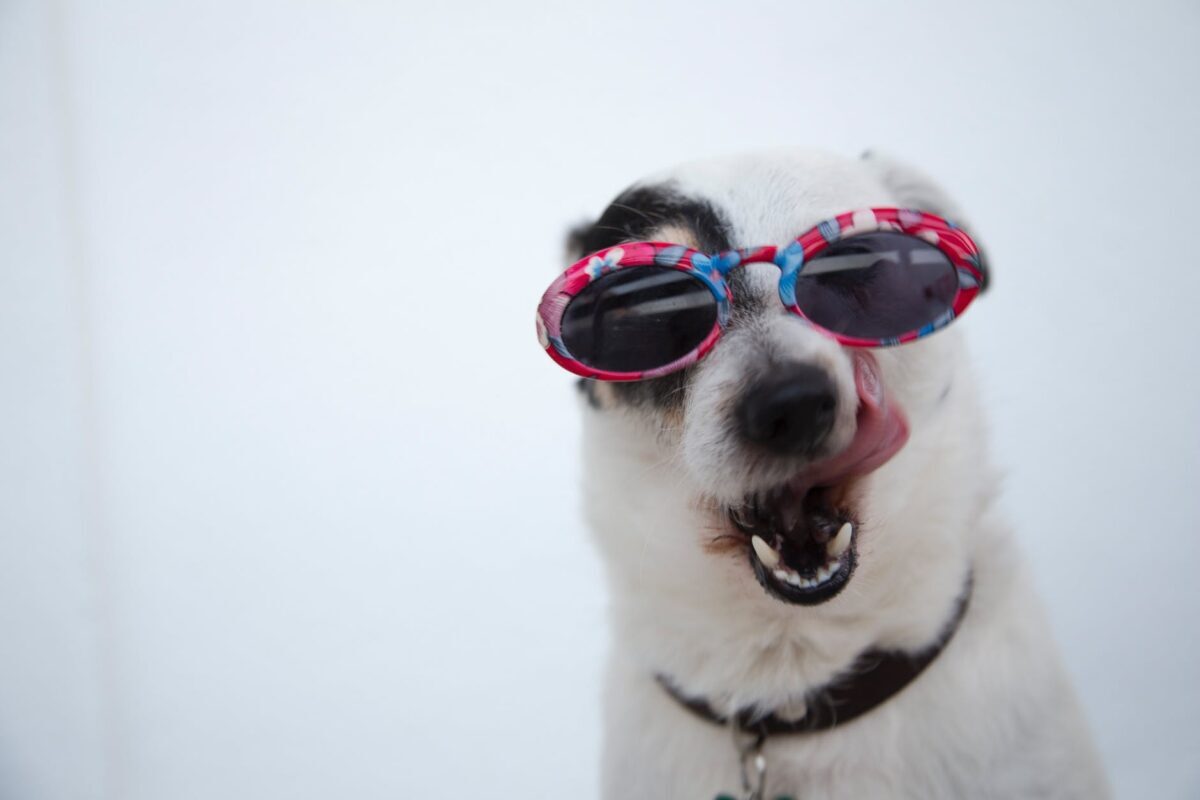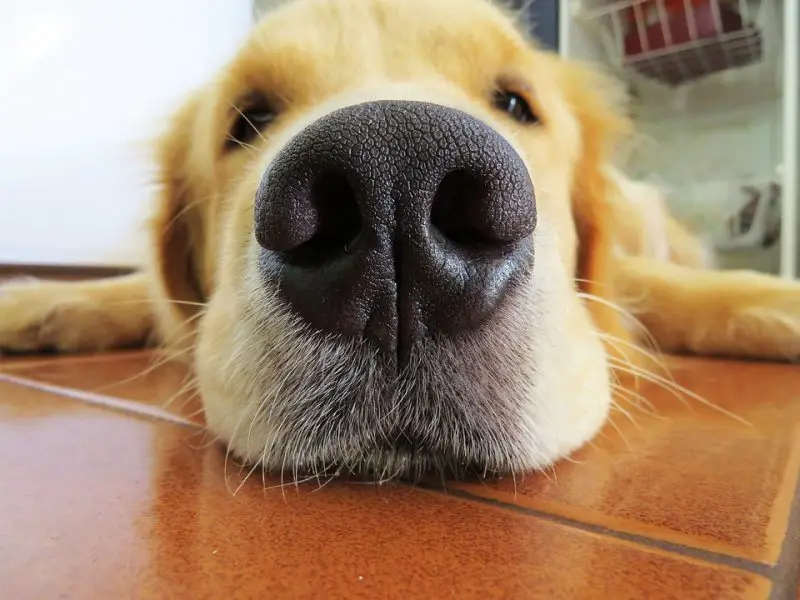Dog has scabs on back near tail. It can of course also be an allergy, perhaps flea allergy. Your dog does not need fleas at all, but a bite from a flea is enough to trigger an allergic reaction. Biting by tail is also sometimes caused by itching or irritation due to overfilled anal glands. It is best to just visit your vet and have this checked.
Always biting in one place can have serious consequences, for example, a hot spot can arise (a blemish wound) that does not heal itself.
How can you identify skin problems in your dog?
Do you recognize one of the 6 symptoms below in your dog? Then there is a good chance that your dog will suffer from skin problems.
- Bare spots and scaly skin
- Itchy skin
- Hair coat
- Thick and greasy skin
- Smelly skin with your dog
- Irritated skin; your dog will scratch, lick and bite a lot
The influence of dog food on skin problems

Skin problems in dogs can be caused by, among other things, feeding the wrong diet. The leading cause of skin problems through nutrition is the use of chemical antioxidants instead of natural antioxidants in animal feed. To preserve the lumps, antioxidants are added to the feed.
The difference in ingredients
As a producer of dog food, you can choose to use chemical antioxidants such as BHA or BHT. You can also choose to use natural antioxidants such as tocopherol. Brands that use natural antioxidants state this explicitly on the packaging “contains natural antioxidants”. Brands that use chemical antioxidants will in many cases, only mention “contains antioxidants”.
Dogs may experience skin problems from chemical antioxidants. This usually starts innocently with scratching and licking a little more often in certain places. This will develop rapidly in irritated, red spots on the skin.
The natural dog food from Nero Gold contains natural antioxidants, namely tocopherol. With the switch to natural food, skin problems will also decrease. Over time, in most cases, even disappear, so that your dog will have a beautiful shiny coat again and will feel comfortable in his or her skin.
Does your dog have skin problems? Try natural dog food
Do you recognize the symptoms in your dog and does your dog have skin problems? Then try the logical chunks of Nero Gold. 95% of our customers recommend Nero Gold, they indicate that feeding the Nero GoldFish & Rice to their dog reduces the symptoms within a few days and with time the dog again has a beautiful, shiny coat and healthy skin. The Nero GoldFish & Rice is salmon-based, and the natural Omega 3 and 6 fatty acids in optimum proportions contribute to a beautiful and shiny coat in the dog.
The 4 most common causes of skin problems in the dog

Many dogs experience problems with the skin and fur once. The reasons for this vary per dog. Here we treat the 4 most common causes of skin and fur problems in the dog.
1. Skin problems due to allergies
Allergies are the most common cause of skin problems in the dog. Allergies develop after the dog has been exposed to it at least twice.
- Flea allergy:
A flea allergy is often located at the lower back of your dog. The dog will get tremendous itching and scratch and bite. For some dogs, this can take severe forms.
- Food allergy:
With a food allergy, your dog is allergic to certain ingredients in food. Your dog will then always suffer from itching. Often this is located at the ears, the bottom of the abdomen and the back of the legs because here the skin is thinnest. Sometimes the itch is also accompanied by a thickening of the skin. This often happens when dogs eat the same food for a more extended period. Food made from a different protein/meat source could be the solution here. The use of chemical antioxidants in diet such as BHA and BHT can cause skin and fur problems in dogs.
By switching to natural foods that also use natural antioxidants, you ensure that many of these skin problems resolve in the dog.
- Atopy:
This is a collective name for skin allergies, which are caused by substances in the environment. It is comparable to hay fever in humans. In a dog, this manifests itself in skin and fur problems with itching of his mouth, ears and paws, armpits and groin. Some complaints can also be seasonal. Allergies caused by substances in the environment are most common in young dogs between the ages of 1 and 4 years. The dog will suffer from itching. Bare irritated spots develop through scratching and licking. Atopy is more common in specific breeds, e.g. West Highland Terrier, Jack Russel and Herders.
2. Skin problems due to dry skin
When your dog suffers from a dry hold, in most cases it will get flakes and dry, rough skin.
Omega 3 and 6 fatty acids have a positive effect on the condition of the skin and fur of a dog. The state of the skin and coat can be improved through nutrition.
Special nutrition provides the necessary extra support to the skin and coat of the dog. It also helps to add extra fish oil and fat sheep cubes to your dog’s food, thereby improving the condition of your dog’s skin and coat.
3. Skin problems caused by mange mite in puppies
The scabies mite is generally more common in puppies around 5 to 6 months old. Usually this mite does not cause any issues. However: when the defence against the bug does not go well, a puppy wants to get skin complaints. Symptoms are often small bald spots on the skin, which can get bigger over time. This can also cause skin inflammation in your puppy. The little spots usually disappear themselves after a while. The large infected areas can be treated at the vets.
4. Skin problems due to fungal infections
Yeast infections are also common in dogs. The ringworm is one of these infections. Bald and flaking spots can recognize the ringworm infection in a dog. Sometimes these places also have a round shape. It also wants to prevent a dog from carrying the fungus without causing skin complaints. It is essential to treat the fungal infection. A ringworm fungus can also be contagious to humans. A ringworm infection develops more often in dogs with reduced resistance. These are generally young, older and sick dogs.
Finding out the exact cause of skin and fur problems in the dog is almost always a lengthy and complicated process. Partly because dogs with skin and fur problems often also get other infections and bacteria too.
Treatment of these infections and bacteria is essential.
Finding the cause of skin problems in the dog
To be able to correct skin problems in your dog, it is necessary to find the underlying cause and to treat this cause. If the underlying cause is not found, the symptoms in your dog will keep coming back.
Elimination process
Researching the exact cause of skin and fur problems in your dog often involves a process of elimination. You start by excluding fleas, infections and bacteria in your dog. Puppies are also checked for scabies. Before proceeding to the investigation for a possible food allergy. Finally, research is often done into an atopy / environmental allergy. Even after completing the entire process, the exact cause is not found in many cases.
These are the most common skin diseases in your dog
Do you see your dog scratching a lot? Or does he have strange spots on his skin? It could well be that your dog will suffer from one of these skin diseases.
Scabies
The Sarcoptic mite causes scabies or scabies in your dog. The bug causes severe itching or other skin complaints. The animal lives in the skin of your dog and lays eggs here.
The condition is very contagious; for example, dogs can get scab due to physical contact with other dogs that have a crust. But they can also get it from mites that live in their environment, such as brushes, baskets and blankets.
Dogs get so itchy that they can scratch themselves open. They get red spots, bumps or scabs on their skin. These spots are most common on their ears, snouts, elbows and heels. If your dog is in a dire state, he can be bothered by his entire body.
Fortunately, scabies can be cured well! Use prednisone also by means of selamectin or with very severe itching. Wash your dog occasionally with antibacterial shampoo; then the crusts can heal well.
Note: owners can also suffer from itching when a dog has a scab. If the complaints disappear with the quadruped, they disappear with you too.
Psoriasis
Psoriasis is a skin disease where your dog gets red scaly patches on his skin. The patches occur mostly on his elbows, legs and between his back and hips. The cause of these spots is a weak immune system. Dogs can develop a nervous immune system due to mediocre dog food. Shampoos, new medicines, plants or dust can also cause an allergic reaction.
You can improve your dog’s immune system by providing the right food and getting off the road with the dog. Exercise is important!
There are also shampoos and ointments for psoriasis. It is useful to visit the vet, so that your dog gets a treatment that suits him best.
Eczema/hotspot
Eczema is actually a collective name for all sorts of skin complaints. For example, redness, swelling, red bumps, scabs, itching and moisture secretion. Eczema is caused by sanding the skin. Eczema spots are usually found on the legs, at the base of the ears and at the back of the back. One variety is more troubled by it than the other, and this is because one type is looser in its skin than the other.
Eczema is very itchy so that dogs can scratch or lick it. This can cause inflammation. The place becomes a so-called ‘hotspot’ when it grows in size in a few hours.
Keep the hygiene of your dog up to date by, for example, washing your dog regularly. The right food is also essential if your dog suffers from eczema.
Treating eczema and hot spots can be done by shaving the fur around the area and by using antibiotics.
Currant beard/impetigo
The current beard or impetigo is a skin inflammation caused by certain bacteria, especially Staphylococci and Streptococci. Pimples, blisters and scabs appear on the skin of your dog. Currant beard mainly occurs around the lips, the chin, around the eyes, but also on the abdomen, in the groin and in the armpits. Young dogs under one, in particular, are affected.
The cause of currant beard or impetigo is not fully known. We do know that poor nutrition or other skin problems can stimulate currant beards. The condition is contagious, especially if the blisters are open. It is wise if you go to the vet if your dog suffers from currant beard or impetigo, then you immediately know whether it can be dissolved with shampoo, or whether antibiotics are needed, for example.
Hair loss/alopecia
Alopecia is a form of hair loss in which your dog gradually becomes bald. There are different forms of alopecia. For example, there is hereditary alopecia, where the dog is already born hairless, but dogs can also become bare from bacteria, allergies, fungi or parasites. If you discover the cause, the hair can quickly come back.
Baldness can also be the result of a hormonal disorder due to a weak functioning of the thyroid gland, a deficiency of the growth hormone and overproduction of a female hormone. The only advantage: the dog is not bothered by itching.
Pigment loss / vitiligo
Vitiligo is a skin disease that causes pigment loss. The spots occur to varying degrees and especially in the nose, mouth, lips, inside of the mouth, eyes and legs. Some dogs have white spots all over their body.
There is no cause for pigment loss, yet we see that the condition is more common in certain breeds of dogs, such as the Belgian Shepherd, Tervueren Shepherd, Dobermann, German Shepherd and Rottweiler.
Vitiligo has no effect on the health of the dog, but unfortunately, it cannot be solved. Yet there are dogs where the pigment returns.
Pruritus
Pruritus is a chronic itch in your dog. There are numerous reasons for this itching. In this case, it is essential to go to the vet for a plan of action immediately. You must exclude causes one by one. Only if you work very carefully and step-by-step in consultation with the veterinarian, a successful solution can be found for your dog.
Refences:
This article is purely informative; at redargentina.com, we have no power to prescribe veterinary treatments or make any diagnosis. We invite you to take your pet to the veterinarian in case he presents any condition or discomfort.

